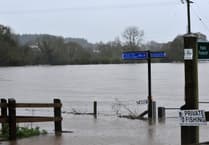NON-TOXIC algae is responsible for a layer of unattractive ‘scum’ seen on the Brook in Dawlish.
The algae has accumulated at the bottom end of the watercourse through the town by the Viaduct.
Onlookers have expressed concern about the recent appearance of the brown substance which has piled up against the temporary mesh fencing.
Town councillor Scott Williams, one of the founder members of the WADE group set up to clean up the Brook, explained: ‘It’s actually algal bloom of Phaeocystis, a common, non-toxic algae, formed in British coastal waters when the temperatures are warmer and there’s more sunlight.
‘Algal blooms are a natural part of water ecology and when they accumulate, more so in early summer, they produce clouds of frog-spawn like colonies which look a little like oil drops in the water.
‘They coincide with the fish spawning, which is egg laying.’
Cllr Williams said he had counted at least eight fish feeding on the substance.
He said: ‘It looks like this when they start to breakdown, a creamy-brown foam can appear on the water so it looks like thin layers or lines due to the river flow.’
Fellow town councillor Rosie Dawson said the netting was in place temporarily to prevent the recently hatched Black Swan cygnets from being swept out to sea.
This is slowing the usual wash through of the surface algae.
WADE - Waterways Around the Dawlish Environment - was set up last year following concerns about the appearance of the Brook.
A group of volunteers is now looking after the watercourse from Tuck’s Plot and York Gardens to Manor Gardens.
The initiative is aiming to encourage community engagement, improve the Brook as well as environmental conservation, bringing the waterway back to its former glory.
Just a few days ago, brown trout have been seen up by the Manor House.
During a recent litter pick last week, volunteers were ‘impressed’ by only finding half a bag of rubbish when they had been expected far more following a busy weekend.
A spokesman said: ‘Thanks to everyone for either using the bins or taking their rubbish home, it is really appreciated.’
WADE’s efforts will be curtailed slightly as the Environment Agency’s salmon breeding season has started and runs until June 15.
Legislation under section 2 of the Salmon and Freshwater fisheries act makes it an offence to disturb spawning fish, or the areas they use.
Fines can run to tens of thousands of pounds.
WADE cannot conduct work which might disturb areas where fish spawn can be susceptible to damage, with eggs nestling directly in weeds, gravel, tree roots or on the sides of those sediment islands.
Young fish that emerge from the eggs are sensitive to silt disturbance, low oxygen and trampling.
The close season is important to the spawning and recovery of many of our river fish species, giving them the best chance to access the right habitat and breed successfully.
As the temperatures slowly climb, the different species will start to look to reproduce, repopulating waters for years to come.




